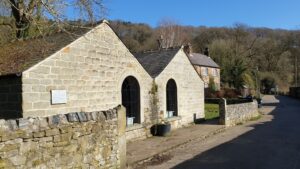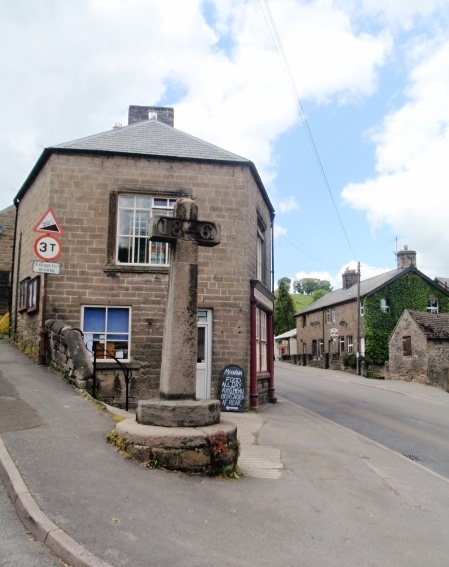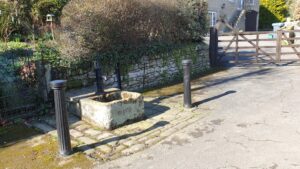Stoney Middleton is mentioned in 1086 in the Domesday Book. The manor is first recorded as being where the King had land:
In Stoney Middleton, Godgyth had four bovates of land to the geld. Land for four oxen. There 6 villans and one bordar have 2 ploughs and four acres of meadow and a little scrubland. TRE[5] as now worth six shillings.
The book then says under the title of “The lands of Ralph fitzHubert”:
In Stoney Middleton Leofnoth and his brother had one carucate of land. There is land for one plough. It is waste. This manor is one league long and 4 furlongs broad.
The village has been thought to be a Roman settlement, perhaps based on lead mining, but there is currently no archaeological evidence to prove this. A nineteenth-century bath house over a hot spring is known locally as The Roman Baths, but this was built in an unsuccessful attempt to establish a spa resort.
A semi-circular earth platform called “Castle Hill” overlooks the village; academic opinion varies as to what this earthwork originally was. It may have been a ringwork castle, or simply the foundations of a summer house. The origins of the name of the village go back to the Saxo-Norman period when it was known as Middletone or Middletune, the name Stoney Middleton literally meaning ‘stony middle farm’.
Stoney Middleton church – Originally the church of St Martin in Stoney Middleton was built by Joan Eyre in thanksgiving for the safe return of her husband, Robert, from the 1415 Battle of Agincourt.
Much of the church was pulled down in 1759 after a devastating fire and all that remains on the original fifteenth century church is the square tower.
Subsequently the the main body of the church was rebuilt, in the same year, with an unusual octagonal nave.
The architect also designed the stables of Chatsworth House and those behind The Crescent at Buxton, Eyam Rectory and Stoke Hall near Grindleford. A century ago church historian, Dr. Charles Cox, grumbled that the architect would have been better to confine his talents exclusively to secular work.’
The interior is of interest, as all the pews face the centre.
There is a tribute to Urban Smith who was vicar for 53 years and when John Riddlesded retires after 47 years pf service he was only the second vicar in a century of continuous service.
Stoney Middleton toll house – In the centre of Stoney Middleton over the brook flowing down Stoney Middleton Dale stands an octagonal tollhouse, built in 1840 by a local joiner George Buxton and William Morton, a stonemason of the nearby village of Froggatt at a cost of £114.14.
Although popularly known as the Roman Baths, there is no evidence that the Romans ever built a bath here. Roman coins have been found locally, so possible offerings were made at the spring. In the Middle Ages, the water was believed to have curative properties and the nearby church is dedicated to St Martin, the patron saint of cripples. The spring has a constant temperature of 63°C In 1734 Dr. Short’s treatise on Mineral Waters claimed that the water could be “drunk more freely and safely than at Buxton, as it is cooler”. It was thought to benefit sufferers from rheumatism and other illnesses less readily recognisable today, such as ‘too great heat’ and ‘saltness of blood’.
The spring has a constant temperature of 63°C In 1734 Dr. Short’s treatise on Mineral Waters claimed that the water could be “drunk more freely and safely than at Buxton, as it is cooler”. It was thought to benefit sufferers from rheumatism and other illnesses less readily recognisable today, such as ‘too great heat’ and ‘saltness of blood’.
In 1789, a writer called Pilkington suggested that more people would try the waters if the then open bath was covered in. Early the next century Thomas Denman, Lord Chief Justice of England and owner of Stoney Middleton Hall took up the idea. By 1815 there were separate baths for men and women, each with its own window, changing room and fireplace. However, his attempt to establish Stoney Middleton as a spa failed and the buildings gradually fell into disrepair.
In 1980 the bath houses were classified as a ‘Listed Building’. Between 1985 and 1992 the bath houses and the surroundings were restored by Stoney Middleton Parish Council, with financial support from the Peak National Park Authority.
Corn Laws cross – Inscribed 1846, this cross was erected to celebrate the repeal of the Corn Laws of 1846 which benefited the working class.
Industry has played an important part in the life of the village, ever since the Romans discovered lead here. Stoney Middleton has at one time or another been involved in businesses as diverse as lead mining, smelting, quarrying, boot and candle making.
Lover’s Leap is a prominent limestone cliff that overhangs Middleton Dale. It acquired its name after an incident in 1762, when a young woman by the name of Hannah Baddaley, attempted to commit suicide by throwing herself over the cliff top. Her lover, William Barnsley, had jilted her, and she had decided to end it all. Miraculously her billowing petticoats acted like a parachute on the way down, until they were caught in brambles protruding from a ledge. This saved her life and all she suffered were a few cuts and bruises. However, this story does not have an happy ending: Hannah died two years later of natural causes, still unmarried. The details of this event are recorded on an information board outside the Lover’s Leap Café that marks the location of the leap.
At the foot of High Street, behind the village Cross stands the Moon Inn. Originally called ‘The Old Moon,’ before it was moved across the road to its present site, when it was called ‘The New Moon’ before adopting its present name. In coaching days, the ‘old’ pub was the principal posting station between Manchester and Sheffield where horses were changed.


